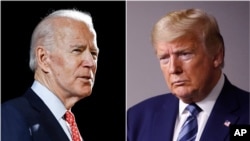U.S. President Donald Trump visited two political battleground states – Florida and North Carolina – Tuesday, while former Vice President Joe Biden unveiled new campaign ads airing in states critical to the outcome of the November 3 election.
While in Jupiter, Florida, Trump signed a memorandum that prohibits drilling in the waters off the Atlantic and Gulf coasts of Florida, and off the Atlantic coast of Georgia and South Carolina for a 10-year period, from July 1, 2022, to June 20, 2032.
He later flew to the city of Winston-Salem, North Carolina, for an evening rally.
Trump won both Florida and North Carolina in the 2016 election en route to a four-year term in the White House, but polls in the two states show him narrowly trailing Biden. A Trump loss in either state would significantly limit his chances of winning a second term.
Before departing Tuesday, Trump said his campaign is doing “very well,” adding poll numbers he has seen were “very good.” He also addressed street violence linked to racial injustice protests in several U.S. cities, saying Biden “doesn’t have the strength” and “mental capability to control” the situation.
The Biden campaign debuted a new 60-second ad in battleground states that attempts to depict the presidential race as a choice between the “darkness” of Trump’s tenure and the possibility of a “fresh start.”
“This is our chance to put the darkness of the past four years behind us, to end the anger, the insults, the division, the violence and start fresh in America,” the narrator says as the ad opens. “We can stop focusing on a president who thinks it’s all about him and start focusing on what’s best for us.”
The Biden campaign said the ad is part of a $47 million time purchase this week on broadcast and digital platforms in battleground states, including Arizona, Florida, Michigan, Minnesota, Nevada, North Carolina, Ohio, Pennsylvania and Wisconsin.
The focus by both Trump and Biden on specific politically divided states is a function of the way U.S. presidential elections are decided, through the Electoral College, not a national popular vote.
Biden, as he has for months, is maintaining his lead over Trump in national polls, by about 7 percentage points, although his lead in battleground states is thinner.
The U.S. decides the presidency through an indirect form of democracy, where the winner in each state receives all of that state’s electoral votes. Each state’s number of electoral votes is based on its population.
Would-be presidents must win at least 270 of the 538 electoral votes. The most populous states – Democrat-controlled California with 55 votes, and Republican-dominated Texas with 38 – hold the most sway. Seven states and the national capital city of Washington have the fewest electoral votes, three apiece.









